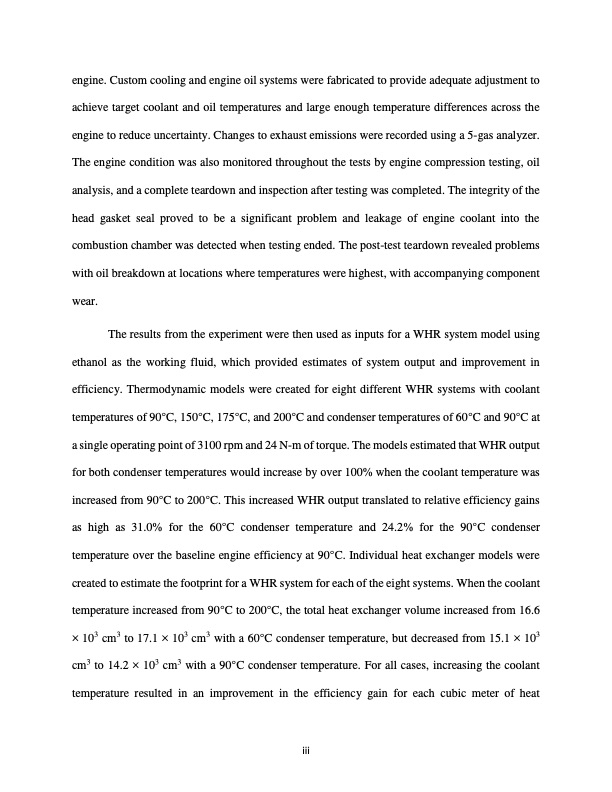
PDF Publication Title:
Text from PDF Page: 004
engine. Custom cooling and engine oil systems were fabricated to provide adequate adjustment to achieve target coolant and oil temperatures and large enough temperature differences across the engine to reduce uncertainty. Changes to exhaust emissions were recorded using a 5-gas analyzer. The engine condition was also monitored throughout the tests by engine compression testing, oil analysis, and a complete teardown and inspection after testing was completed. The integrity of the head gasket seal proved to be a significant problem and leakage of engine coolant into the combustion chamber was detected when testing ended. The post-test teardown revealed problems with oil breakdown at locations where temperatures were highest, with accompanying component wear. The results from the experiment were then used as inputs for a WHR system model using ethanol as the working fluid, which provided estimates of system output and improvement in efficiency. Thermodynamic models were created for eight different WHR systems with coolant temperatures of 90°C, 150°C, 175°C, and 200°C and condenser temperatures of 60°C and 90°C at a single operating point of 3100 rpm and 24 N-m of torque. The models estimated that WHR output for both condenser temperatures would increase by over 100% when the coolant temperature was increased from 90°C to 200°C. This increased WHR output translated to relative efficiency gains as high as 31.0% for the 60°C condenser temperature and 24.2% for the 90°C condenser temperature over the baseline engine efficiency at 90°C. Individual heat exchanger models were created to estimate the footprint for a WHR system for each of the eight systems. When the coolant temperature increased from 90°C to 200°C, the total heat exchanger volume increased from 16.6 × 103 cm3 to 17.1 × 103 cm3 with a 60°C condenser temperature, but decreased from 15.1 × 103 cm3 to 14.2 × 103 cm3 with a 90°C condenser temperature. For all cases, increasing the coolant temperature resulted in an improvement in the efficiency gain for each cubic meter of heat iiiPDF Image | WASTE HEAT RECOVERY FROM A HIGH TEMPERATURE DIESEL ENGINE

PDF Search Title:
WASTE HEAT RECOVERY FROM A HIGH TEMPERATURE DIESEL ENGINEOriginal File Name Searched:
Adler_colostate_0053N_14539.pdfDIY PDF Search: Google It | Yahoo | Bing
NFT (Non Fungible Token): Buy our tech, design, development or system NFT and become part of our tech NFT network... More Info
IT XR Project Redstone NFT Available for Sale: NFT for high tech turbine design with one part 3D printed counter-rotating energy turbine. Be part of the future with this NFT. Can be bought and sold but only one design NFT exists. Royalties go to the developer (Infinity) to keep enhancing design and applications... More Info
Infinity Turbine IT XR Project Redstone Design: NFT for sale... NFT for high tech turbine design with one part 3D printed counter-rotating energy turbine. Includes all rights to this turbine design, including license for Fluid Handling Block I and II for the turbine assembly and housing. The NFT includes the blueprints (cad/cam), revenue streams, and all future development of the IT XR Project Redstone... More Info
Infinity Turbine ROT Radial Outflow Turbine 24 Design and Worldwide Rights: NFT for sale... NFT for the ROT 24 energy turbine. Be part of the future with this NFT. This design can be bought and sold but only one design NFT exists. You may manufacture the unit, or get the revenues from its sale from Infinity Turbine. Royalties go to the developer (Infinity) to keep enhancing design and applications... More Info
Infinity Supercritical CO2 10 Liter Extractor Design and Worldwide Rights: The Infinity Supercritical 10L CO2 extractor is for botanical oil extraction, which is rich in terpenes and can produce shelf ready full spectrum oil. With over 5 years of development, this industry leader mature extractor machine has been sold since 2015 and is part of many profitable businesses. The process can also be used for electrowinning, e-waste recycling, and lithium battery recycling, gold mining electronic wastes, precious metals. CO2 can also be used in a reverse fuel cell with nafion to make a gas-to-liquids fuel, such as methanol, ethanol and butanol or ethylene. Supercritical CO2 has also been used for treating nafion to make it more effective catalyst. This NFT is for the purchase of worldwide rights which includes the design. More Info
NFT (Non Fungible Token): Buy our tech, design, development or system NFT and become part of our tech NFT network... More Info
Infinity Turbine Products: Special for this month, any plans are $10,000 for complete Cad/Cam blueprints. License is for one build. Try before you buy a production license. May pay by Bitcoin or other Crypto. Products Page... More Info
| CONTACT TEL: 608-238-6001 Email: greg@infinityturbine.com | RSS | AMP |